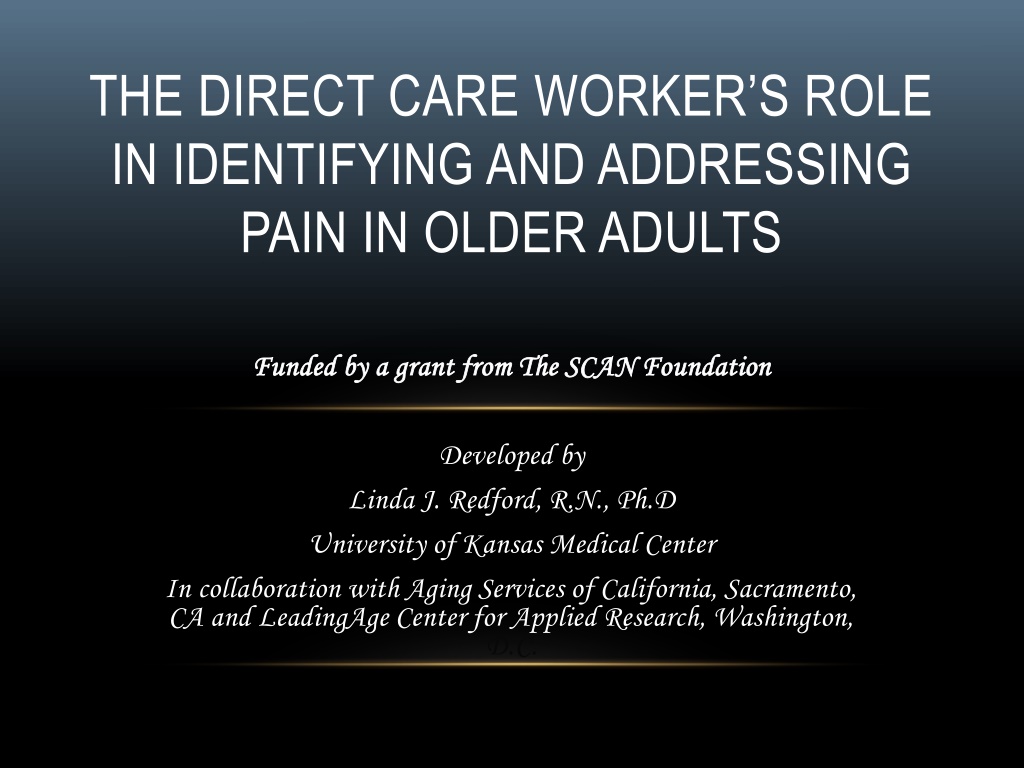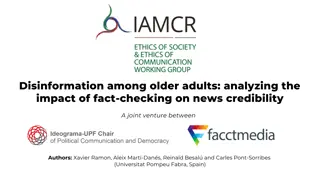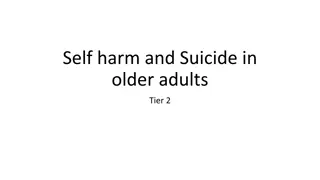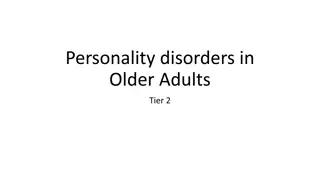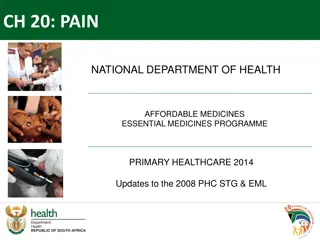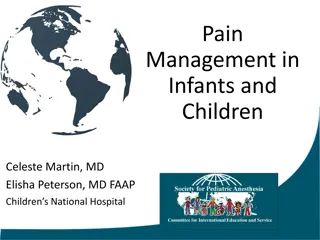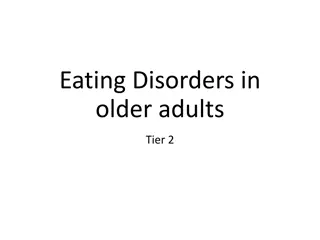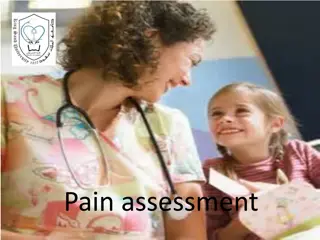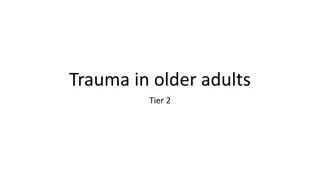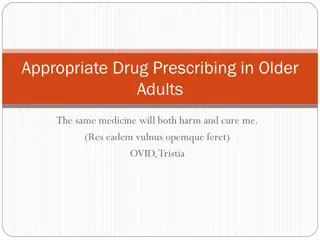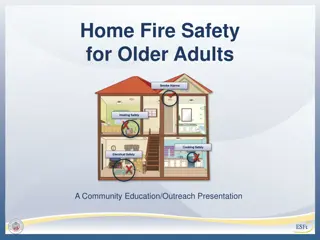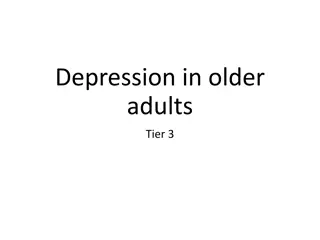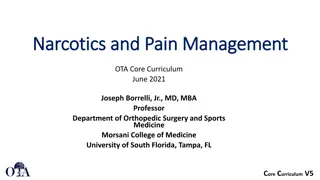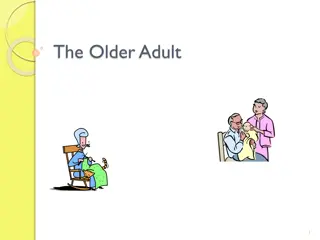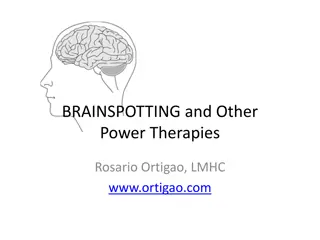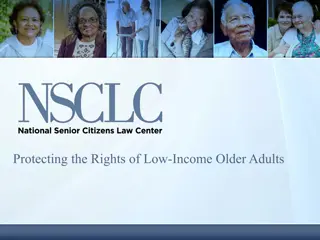Understanding and Implementing Non-Drug Therapies for Pain in Older Adults
This resource provides information on the role of direct care workers in identifying and addressing pain in older adults, funded by The SCAN Foundation. It covers misconceptions about non-drug approaches to pain, various non-drug therapies like physical positioning and music, and tips on when to use them. The content emphasizes that non-drug therapies are not substitutes for medication but can be effective in managing pain, especially when combined with appropriate drugs.
Download Presentation

Please find below an Image/Link to download the presentation.
The content on the website is provided AS IS for your information and personal use only. It may not be sold, licensed, or shared on other websites without obtaining consent from the author. Download presentation by click this link. If you encounter any issues during the download, it is possible that the publisher has removed the file from their server.
E N D
Presentation Transcript
THE DIRECT CARE WORKERS ROLE IN IDENTIFYING AND ADDRESSING PAIN IN OLDER ADULTS Funded by a grant from The SCAN Foundation Funded by a grant from The SCAN Foundation Developed by Linda J. Redford, R.N., Ph.D University of Kansas Medical Center In collaboration with Aging Services of California, Sacramento, CA and LeadingAge Center for Applied Research, Washington, D.C.
Module 2 WHAT YOU CAN DO TO HELP A RESIDENT WHO IS EXPERIENCING PAIN
AT THE END OF THIS SESSION, YOU WILL BE ABLE TO-- List two misconceptions about nondrug approaches to pain. Describe at least four nondrug approaches to relieving pain. Discuss when and when not to use specific nondrug approaches. Discuss barriers to use of nondrug approaches in managing pain.
NONDRUG THERAPIES FOR PAIN Physical Positioning Exercise Heat Cold Massage Vibration Psychosocial Distraction Music Relaxation Imagery Comfort food Controlled breathing
MISCONCEPTIONS ABOUT NONDRUG THERAPY Wrong Nondrug therapies are substitutes for drug therapies. Right Nondrug therapies are used alone only if they are effective in relieving the pain. Usually it is necessary to use appropriate pain drugs along with nondrug therapies.
MISCONCEPTIONS ABOUT NONDRUG THERAPY Wrong If distraction relieves pain, the pain isn t real . Right Distraction is a very effective strategy for relieving some types of pain. Distraction helps pain medication work more effectively by helping the person relax.
MISCONCEPTIONS ABOUT NONDRUG THERAPY Wrong Nondrug therapies don t work for serious pain. Right Nondrug therapies do work for serious pain, especially when combined with appropriate medications.
POSITIONING Make certain -- not lying on a wrinkle in the bed or seat, not lying against a sore extremity, body aligned properly, not left too long in the same position.
EXERCISE Movement can relieve pain. Keeps joints moving. If it causes worsening of the pain, DON T DO IT.
CAUTIONS WITH EXERCISE Get approval of the medical provider to do exercises. Work with a physical therapist in identifying appropriate exercises. STOP if pain increases.
HEAT Heat is best used for chronic pain. It helps to relax muscles, ease discomfort in sore joints, increase blood flow to muscles, and increase flexibility.
HEAT Can use warm towels, hot water bottle, or heating pad as a source of heat. Heat should be between 104 and 113 degrees Fahrenheit. USE A THERMOMETER TO CHECK TEMPERATURE BEFORE APPLYING.
CAUTIONS WHEN USING HEAT DO NOT APPLY HEAT DIRECTLY ON SKIN. Place a towel or thick cloth between the heat source and the skin. Do not apply for more than 20 minutes at a time.
CAUTIONS WHEN USING HEAT DO NOT use heat on a new injury or immediately after exercise. DO NOT use heat on a person with decreased blood flow to an area or decreased ability to feel heat or cold.
CAUTIONS WHEN USING HEAT DO NOT use heat on an area that is newly inflamed (red, swollen, warmer than the surrounding area)
CAUTIONS WHEN USING HEAT DO NOT use heat when a person is sleeping. DO NOT use heat with person lying on top of the pad (pressure increases heat). DO NOT use heat if has certain health conditions. IF PAIN INCREASES, STOP USING HEAT!
COLD Reduces pain by- Decreasing inflammation Numbing nerve endings Reducing muscle spasms Reducing swelling .
WHEN TO USE COLD New (acute) injuries not if skin is broken. Chronic pain (like arthritis)- if it helps. To massage sore joints. To reduce desire to scratch areas that itch.
ADVANTAGES OF COLD It is more effective in relieving many kinds of pain, particularly pain from irritated nerve endings and pain from inflammation. It works more quickly in relieving pain. The effects last longer.
CAUTIONS WHEN USING COLD DO NOT APPLY COLD DIRECTLY ON SKIN. Place a towel or thick cloth between the ice pack and the skin. Do not apply for more than 20 minutes at a time.
CAUTIONS WHEN USING COLD DO NOT use cold on an open wound. DO NOT use cold on severe injuries.
CAUTIONS WHEN USING COLD DO NOT use cold on areas being treated with radiation. DO NOT use cold on areas with poor circulation.
CAUTIONS WHEN USING COLD DO NOT use cold with certain health conditions. DO NOT use cold if the individual is highly sensitive to cold.
MASSAGE Enhances relaxation. Relieves painful muscles. Is safe if used appropriately. Provides human touch. Is an inexpensive intervention unless using a trained therapist for advanced techniques.
TYPES OF MASSAGE Lightly massaging hands with warm lotion. Soaking feet in warm (not hot) water and lightly rub.
TYPES OF MASSAGE Lightly massaging shoulders to relax sore muscles. Massage back lightly with warm lotion at bedtime or when the person is becoming anxious.
CAUTIONS WITH MASSAGE DO NOT massage over broken skin. DO NOT use vigorous strokes or hard pressure.
CAUTIONS WITH MASSAGE DO NOT massage lower extremities without a doctor s order. DO NOT massage over areas of tumors or bone metastases. DO NOT massage areas that are red and unusually warm to the touch. DO NOT use if it makes resident uncomfortable. STOPif pain gets worse!
DISTRACTION The purpose of distraction is to divert person s attention away from their pain.
DISTRACTION Approaches to distracting a resident who is in pain. Look at pictures with the resident. Talk about events that interest the resident. Play music. Use various relaxation techniques.
IMAGERY Approach to doing guided imagery. Encourage the person to imagine a place or setting they love. If needed, show them pictures of scenes that are calming and peaceful. Have them imagine they are in the picture. Ask them to describe the sounds, the sights, the smells
DEEP BREATHING Slow, deep breathes-relax the body, reduce stress, and serve as a distraction. Approach to deep breathing- Breathe from the abdomen. Take in a slow, deep breaths, hold breath to the count of 4, and let it out. Breath in through the nose and out through the mouth. Do not use if deep breaths increase pain.
PROGRESSIVE MUSCLE RELAXATION Helps relieve stress and promotes relaxation. Residents may need to be coached in conducting this exercise. Approach to progressive muscle relaxation- Start with one part of the body, usually a foot. Have the resident tighten the muscles in the foot and hold it to the count of 10. Have them slowly relax the muscles in the foot and feel the tension melt away. Continue this with the other foot, the leg, the buttocks, and other muscle groups working up to the face.
DISTRACTION Considerations/precautions Most effective for mild pain if used alone. Most effective for moderate to severe pain if used with a pain medication. Do not doubt that the person is in pain just because they can be distracted. The effect is not likely to last for a long period.
MUSIC Music is used to encourage emotional expression relieve pain provide an overall sense of well-being relieve stress http://www.youtube.com/watch?v=aPRkgkZHjqI
CAUTIONS IN THE USE OF MUSIC Taste in music is very individual. It the music is distasteful to a person, it can increase agitation and discomfort.
PET THERAPY Animals can both distract and calm persons in pain, helping them to relax.
OTHER FORMS OF NONDRUG THERAPY Vibration Can help with chronic muscle pain. Comfort foods Bring back good memories. Help relax and calm person.
NONDRUG PAIN INTERVENTIONS Advantages Gives resident feeling of more control and involvement. Fewer potential side effects. Improves response to pain medication. Used with medications unless effective alone. Generally lower cost than drugs. Adapted from Ersek, M. (2003). Strategies to Enhance Pain Management in Nursing Homes. Swedish Medical Center.
NONDRUG PAIN INTERVENTIONS Disadvantages Sometimes time-consuming. Some therapies require extensive training. Staff or resident may be unwilling to try. Think it won t help. Think it will be done instead of giving medication. Adapted from Ersek, M. (2003). Strategies to Enhance Pain Management in Nursing Homes. Swedish Medical Center.
NONDRUG PAIN INTERVENTIONS Disadvantages (continued) Some techniques do not work or should not be used with certain residents (e.g. cognitively impaired and those with certain medical conditions).
NONDRUG PAIN MANAGEMENT STRATEGIES ARE A CRITICAL PART OF A GOOD PAIN MANAGEMENT PROGRAM.
Anytime a resident appears to be in severe pain, report it to the nurse immediately. Do not attempt any interventions.
If resident is in mild to moderate discomfort, check for and attempt to remedy the cause of the discomfort. If ineffective, report observations to the nurse.
WHAT TO DO IF YOU THINK A RESIDENT IS HAVING PAIN- Gather as much information as possible. Report specific signs of pain to the nurse. Try simple and safe nondrug strategies- divert attention with conversation, singing, repositioning, touch. Document what you see. Document what helps.
